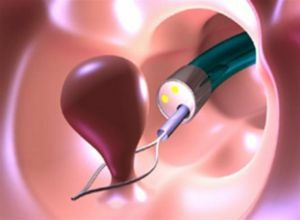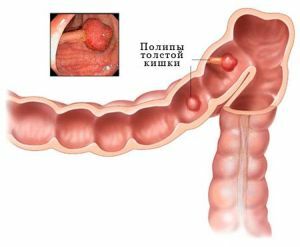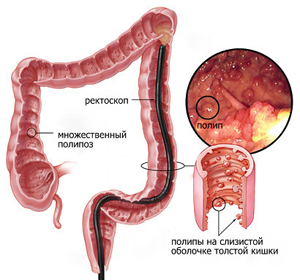 Human intestine is very vulnerable to various diseases and growths.
Human intestine is very vulnerable to various diseases and growths.
To date, a lot of information about each problem has been collected.
The most common formations in the colon include polyps. What is it, and how to deal with them?
Contents of
- What is a polyp?
- Differences from hemorrhoids
- Types of formations
- Reasons for formation and risk factors
- Symptoms of the disease
- Diagnosis of the disorder
- The operation is the only way out
- Folk recipes
- Possible complications
- To not get sick. ..
What is a polyp?
The formation of polyps in the colon agitates all the world's coloproctologists, because bowel cancer most often develops due to the development of the presented problem.
Polyps are benign tumors formed from the glandular epithelium of the large intestine mucosa.
In form these formations are mushroom-like, branchy and spherical. They rise above the level of the mucosa of the large intestine on a thin stalk or on a wide base.
Neoplasms come in different sizes and shapes, multiple or single, but in any case their appearance signals a possible oncological disease.
Difference from hemorrhoids
Polyps of the large intestine and hemorrhoids are different diseases, but with similar symptoms, only in the outgrowths under consideration are the symptoms of  hidden, and for a long time may not manifest at all.
hidden, and for a long time may not manifest at all.
As with hemorrhoids, in the case of the appearance of polyps in the stool, bloody inclusions can be present, bright red blood is isolated and damaged, and the buildup is mechanically injured, constipation is possible due to obstruction of stool.
Hemorrhoids are inflamed and bleeding nodules in the rectum, and polyps are pathological modifications of the cells of the mucous membrane of the large intestine.
Types of formations
Polyps are classified:
- in the form of ( mushroom-shaped on a thin or thick stem, like a bunch of grapes, like a dense knot);
- by number of ( single - one polyp is diagnosed, multiple - grouped or scattered, diffuse, when polyps are very numerous and can not be counted);
- on the histological structure of .
On the histological structure of polyps of the colon are:
- The glandular or adenomatous - are found most often, in 50% of cases. Expand from the tissue of the epithelial glands of the colon and have a mushroom-like, branchy or spherical shape. The sizes of such polyps reach 2-3 cm, located on a broad peduncle or on the base. They have a pink color, rarely bleed, but most often they go to cancer.
- Insect-like - occur in 14% of cases, are formed from epithelial tissue, have the appearance of a node or a creeping shape. Because of the presence of blood vessels in it, they have a red tint, they reach a size of more than 3 cm. They often bleed, ulcerate and necrotic. Go to cancer in 40% of cases.
- Glandular villous - occur in 20% of cases, have a knotty or carpet shape, covered with a lot of villi. Turn to cancer in 90% of cases.
- Hyperplastic - are the least common, in only 2% of cases. They measure up to 0.5 cm, consist of elongated and cystic crypt extensions and have a soft consistency.
The type of neoplasm directly affects the course of treatment and the time of recovery.
Reasons for education and risk factors
Under normal conditions, the cells of the mucosa of the rectum and colon are constantly updated. Due to a malfunction in the functioning of the body, the cells begin to change unevenly, which leads to the formation of the type of outgrowth presented.
Their formation is facilitated by the presence of certain factors:
- genetic predisposition;

- unbalanced food - eating fatty foods and lacking fiber;
- chronic constipation with the use of drugs that irritate the intestinal wall;
- some bowel diseases: ulcerative colitis, Crohn's disease, chronic hemorrhoids;
- smoking and other bad habits;
- sedentary lifestyle;
- age after 50 years.
Polyps are often formed due to frequent use of alcohol and foods that irritate the intestinal mucosa.
Symptoms of the disease
In general, the appearance of polyps passes asymptomatically. Discovered type of growth is usually accidental when diagnosed with an endoscope of other diseases.
They appear when they are already reaching large sizes, or their number exceeds the permissible values.
Symptoms of polyp formation are:
- abdominal pain, in the anus and at the sides;

- painful stool;
- alternation of diarrhea and constipation;
- mucus discharge from the rectum and bleeding;
- appearance of anemia and exhaustion;
- the mucus secretion corrodes the anus area, resulting in itching and burning.
Diagnosis of violation
 Diagnosis is performed by a gastroenterologist. The main method is a colonoscopy - a study of the intestine with a special device( endoscope), introduced into the anus and conducting an examination to a depth of one meter.
Diagnosis is performed by a gastroenterologist. The main method is a colonoscopy - a study of the intestine with a special device( endoscope), introduced into the anus and conducting an examination to a depth of one meter.
Due to the presence of forceps in the endoscope during the examination, tissue is taken for biopsy and small polyps are removed.
Before a colonoscopy, a doctor can prescribe:
- to pass a feces analysis for the presence of blood;
- undergo irrigoscopy( intestinal X-ray with the introduction of contrast medium);
- sigmoidoscopy( examination of the intestine at a depth of 30 cm using an anoscope and taking tissue on a biopsy);
- and also independently carry out finger research.
The operation is the only output of
The goal of treating polyps in the large intestine is their complete removal. It is impossible to delay with the decision of this problem, as untimely treatment is fraught with serious consequences.
Treatment of polyps with conservative medicamental methods does not give a positive result. The use of various drugs will not lead to their reduction and complete elimination.
With medications, you can only reduce pain from permanent mechanical damage.
Polyps removal is carried out by different methods, the choice depends on the type of build-up, their number, size and condition.
The following types of surgical intervention are distinguished:
- Single and multiple small size formations are removed at the colonoscopy of the by a special endoscope, as mentioned above. In the rectum, an endoscope is inserted on a flexible hose equipped with a loop electrode. Moving along the intestine, the device throws a loop on the leg of the built-up edge, then cuts it from the food. Over time, it dries up and disappears, comes out with feces when it is defecated. Similar removal of outgrowths of large sizes occurs in parts. Samples of tissues are additionally sent for histology to exclude oncology. Endoscopic removal of polyps is a gentle operation that does not require a recovery period and is tolerated well by patients.
- Small lesions can be removed by using laser coagulation, radio wave surgery and electrocoagulation .Removal occurs due to a directional laser beam or a radio wave of high power. With this effect, nearby tissues do not suffer, since it occurs at the cellular level. Vessels are also coagulated, which eliminates bleeding.
- Electrocoagulation makes it possible to burn polyps by electric discharge. Such surgical interventions are painless and less traumatic. They are conducted out-patient and do not require postoperative rehabilitation.
- But the diffuse multiple polyps are treated with the surgical method .The entire affected area of the intestine is removed. After such intervention and when removing large, multiple and villous polyps of any size, the patient should be under the supervision of a surgeon for 2 years. A year after the operation, a control endoscopic examination is performed.
The method of removal of outgrowths will be determined only by the attending physician by conducting complex diagnostics.
How is the removal and extraction of colon polyps:
Folk recipes
Folk remedies can be treated with small growths, the kinds of which do not degenerate into cancer. This is a long treatment, requiring patient patience, and also conducted under the supervision of a specialist. Here, decoctions and infusions of herbs are used. 
For internal use it is possible to make infusions of the usual scallop, golden mustache, decoctions of the Kalina or celandine, which have anti-inflammatory and antitumor properties.
Small enemas with decoction of celandine bring a good result. If everything is done correctly, the polyps can disappear.
Camphor oil with honey is also used that mixes in equal amounts and is used in the form of tampons that are inserted into the gut all night.
Possible complications of
 Ignoring the treatment of polyps of the large intestine can provoke their degeneration into cancer tumors.
Ignoring the treatment of polyps of the large intestine can provoke their degeneration into cancer tumors.
Especially dangerous in this respect are growths of a villous species.
After surgical removal, bleeding may occur for several days.
During surgery, there is also a high probability of perforation of the colon wall due to a deep burn of tissues.
In order not to be ill. ..
Precise preventive measures guaranteeing one hundred percent success do not exist. Experts believe that it is possible to prevent formation by following certain rules:
- to monitor its food - to eat less fatty, fried, sweet, flour foods and give preference to vegetables, fruits, cereals;
- drink more fluid ;
- do not eat foods that irritate the mucosa of the large intestine ;
- to quit smoking and alcohol ;
- to lead an active lifestyle .
Having found out unpleasant symptoms, do not prolong it with the reference to experts, and also do not self-medicate.
Correct diagnosis and timely removal of colon polyps will save you from their degeneration into oncology and will enable you to live a long and happy life.
